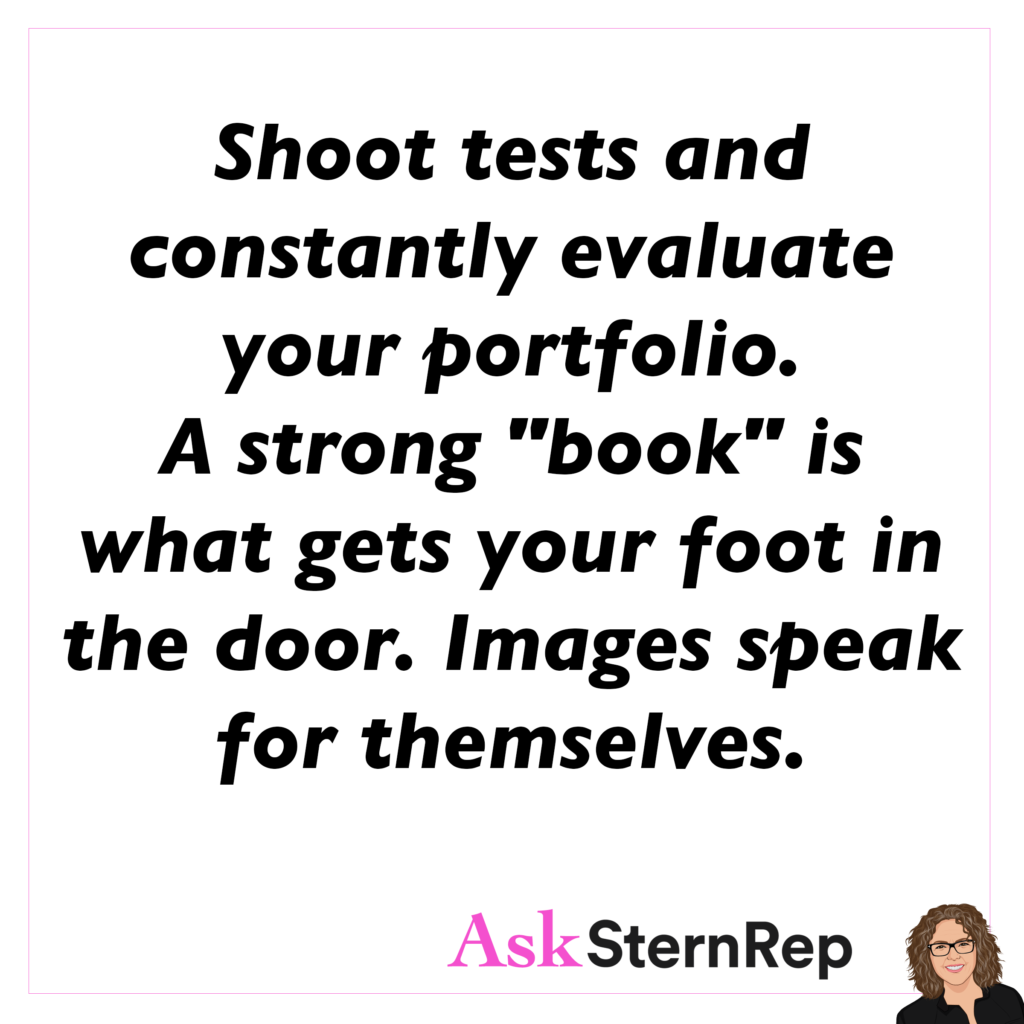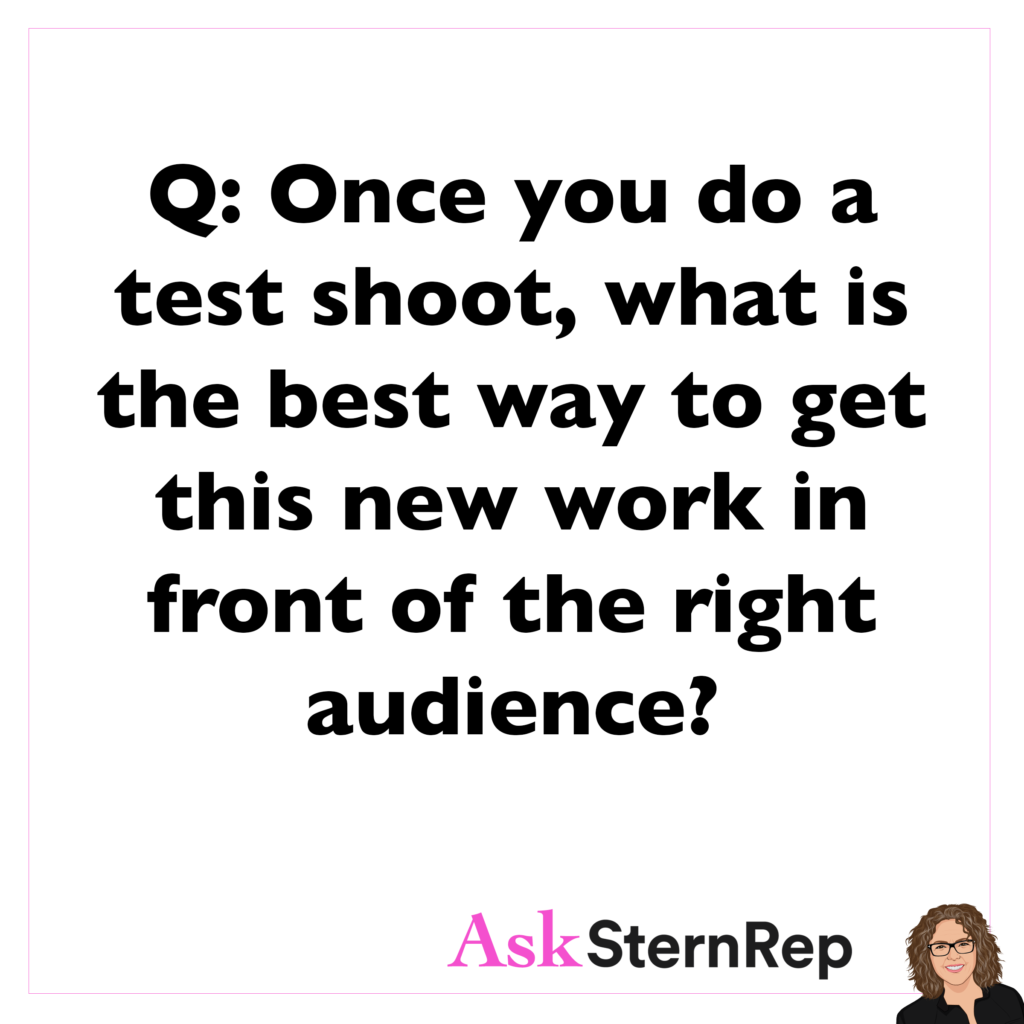
What a rep needs from you is something to say. Tests, new work, content, a story, anything to give us something to share about you.

What a rep needs from you is something to say. Tests, new work, content, a story, anything to give us something to share about you.


How can a photographer implement their personal style and vision throughout their work when the majority of their work has been art-directed by their client for various and specific styles?
This could be the million-dollar question that makes or breaks a photographer’s success. As busy as a photographer is, the images will always reflect a client’s vision of jobs from the past. So much of what clients want to see is what you can bring to the job for the future. The magical word is “Test.” Keep testing, no matter how busy you are. Bring your personal look into images and show who you are.

Shoot tests and constantly evaluate your portfolio.
A strong “book” is what gets your foot in the door. Images speak for themselves.
Slow times = time to improve.
No way to say that differently, as we should all keep pushing the creative clock and get better. Why waste valuable time thinking we get time off if we aren’t on a photo job? Plain and simple- we full-time freelancers are always on our clock pushing ourselves forward, or we will lose our lead in the industry.
Today, we discuss the challenges freelancers, particularly photographers, face during slow periods in their business. Instead of viewing downtime as wasted time, we should utilize this time constructively. We should continue working, even when we are not engaged in paid projects. This could involve collaborating with other professionals, exploring new creative avenues, and enhancing our portfolios. Reaching out to peers in the industry can lead to fruitful collaborations, allowing photographers to diversify their skills and expand their networks. Ultimately, turn slow periods into opportunities for growth and improvement.
Freelancers, particularly photographers, can navigate slow periods in their careers. By reframing downtime as an opportunity for growth, collaboration, and creativity, professionals can not only enhance their skills and portfolios but also build meaningful connections within the industry. Continuous improvement and maintaining a strong work ethic serve as a reminder that every moment spent working—whether on paid projects or personal development—is an investment in one’s future success.


How do I spend my time (and money) wisely to not waste time keeping my portfolio updated to get me where I want to go?
Testing is the strategic core to success, but it requires you to play it smart:


Once you do a test shoot, what is the best way to get this new work in front of the right audience?
As a rep, this is one of my favorite topics because this is the purpose of testing. Reps and consultants’ goals are all about shaping the long-road path. I call this- “growing forward.” Every test should have a client in mind, and with that comes the OUTREACH follow-through to share the images with the appropriate “warm” and “cold” potential clients. Outreach happens on all platforms, including personalized communication, to upgrade clients to a warmer level than where they are now. You want to be good enough to be on their list when that specific type of project comes up. This is either a monotonous process or a fine-tuned, distinct, mapped-out marketing plan.

Test with purpose.


In building my portfolio, I test often with many models as a trade deal. The problem with this is when I send the model the raw images, they ask for all of them. I don’t want my name associated with all the images, so how can I set this boundary to only share the best images?
All photographers – make every term on your test or job estimate form clearly agreed upon BEFORE the job begins.
Term topics to cover:
1. A certain amount of final images to be shared.
2. Retouched/finished images are to be used only and cannot be edited in use.
3. Usage rights permitted for the model and photographer need to be clearly stated and agreed upon in an official talent release form.
4. Payment to models must occur on the same shoot day.
4. Copyright is the photographer’s, and the photographer must agree upon any other usage by the model in perpetuity.


I’ve spent time sending samples of my work for a company I thought I’d be perfect to work with. They finally responded with some interest in me by holding some dates, but they released me. What shocked me was the rate of $1500 for the shoot. Is this normal? I understand I am just getting started, but it felt low for the company’s size and brand recognition.
Kudos to you for getting your work out there to the companies you want to work with. That is step one. I see the increase of $1500 rates due to a heavily saturated industry with more in-house marketing clients, more photographers, and more marketing opportunities for all of us to be in direct contact with our dream clients. Take the feedback as a stepping stone to growing your dream client list, increasing your marketing options, and fine-tuning your testing/branding focus.


All my work so far has been just me or me and one assistant. I want to start building up to bigger productions. It makes sense to start with a personal test project or two to expand my portfolio, practice working under new conditions, make connections with possible crew members, etc. How do I gradually build up my productions, and in what order should I start adding crew, e.g., prop & wardrobe stylists, HMU, digital tech, producer, etc.? Or does that depend on the specifics of each job?
Production Value is one of our highest industry-level rating metric systems controlling photographers’ careers. Why? Clients want to know what to predict if they hire you. They want to see proof that you can control the outcome of their project and not leave it to a moment of chance. In saying that, we must also incorporate the market’s popular trends toward a natural editorial feel of “realness.” Aside from having a consistent, steady message in your overall portfolio, commercial advertising requires high-quality styling. Whether it’s food, hair/makeup, wardrobe, or props – stylists are the #1 factor in raising the production value of a photographer’s portfolio.